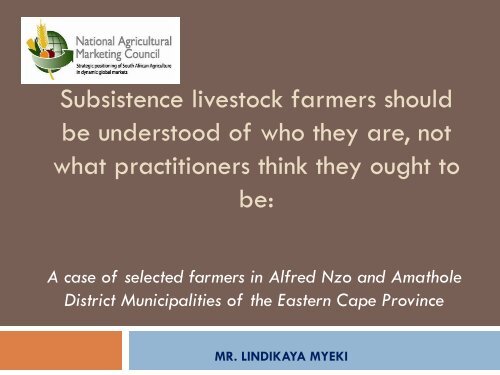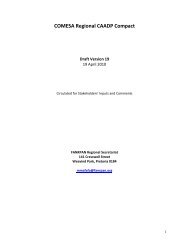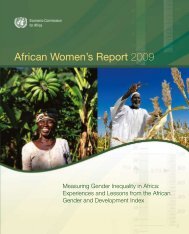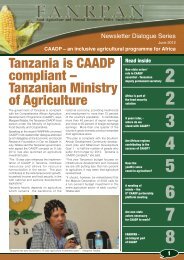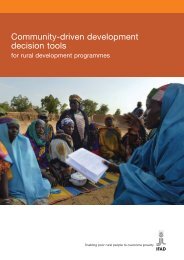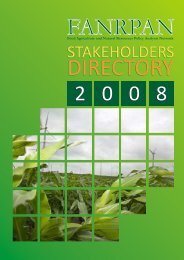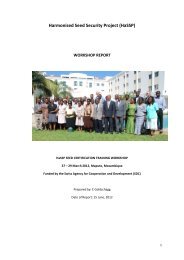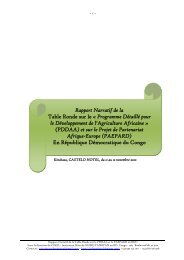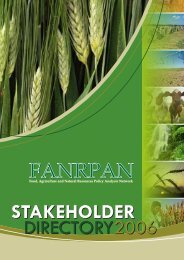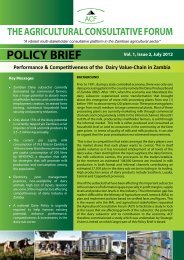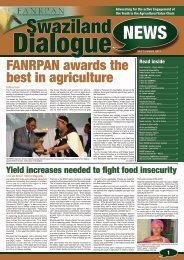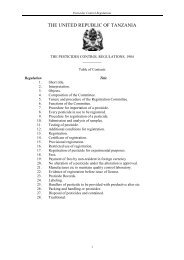Subsistance livestock farmers - NAMC
Subsistance livestock farmers - NAMC
Subsistance livestock farmers - NAMC
- No tags were found...
You also want an ePaper? Increase the reach of your titles
YUMPU automatically turns print PDFs into web optimized ePapers that Google loves.
Subsistence <strong>livestock</strong> <strong>farmers</strong> shouldbe understood of who they are, notwhat practitioners think they ought tobe:A case of selected <strong>farmers</strong> in Alfred Nzo and AmatholeDistrict Municipalities of the Eastern Cape ProvinceMR. LINDIKAYA MYEKI
OUTLINE Brief Background The status of communal <strong>livestock</strong> sector Data collection approach How are these <strong>farmers</strong> looking? Conclusion
BACKGROUND: LIVESTOCK SECTOR IN SOUTH AFRICA 69 percent of South Africa’s land size is suitable for<strong>livestock</strong> (cattle, sheep and goats) production(McDermott et al, 2010). Livestock is the largest agric sector it terms of itscontribution to country’s GDP (excl subsistence farming). Main market channels (DAFF, 2002);- Auction- Carcass grade- Informal markets Small scale <strong>farmers</strong> (serving informal markets) Vs Largecommercial (servicing formal markets).
BACKGROUND: LIVESTOCK SECTOR IN SOUTH AFRICA 45% marketed through informal markets vs. 55%through formal markets (Van Zyl et al, undated). The area of concern in this study is informal markets. Characterized by direct selling to consumers (DAFF,2002). Buying decision of cattle focuses on:• Older oxen,• Bigger, and• Fat. Small-scale <strong>farmers</strong> largely serve the informal markets(Costales et al , 2007).
WHAT IS THE STATUS: THROUGH THE EYES OFPRACTITIONERS – ARE THESE RIGHT?Rangelands in communal areas is argued to be vastly overstockedand on the brink of ecological collapse (it’s been idlilling all along).• Free rider problem inherent in communal systems, and• It is argued further that there are no incentives to manage grazingresources.There are more males than female.Calving rate is negligebly low,Off-take (to the market) is negligible - well under 10% of totalherd size per annum, and consequently these production systems arewasteful in terms of their use of scarce grazing resources.Livestock production techniques in the communal sector arebackward and exhibit little or no regard for scientific productiontechniques.
“It is a capital mistake to theorize beforeyou have all the evidence. It biases thejudgment”Sherlock Holmes.
HOW ARE THESE FARMERS LOOKING?Age and Experience Confirms the argumentthat <strong>farmers</strong> are aging(Salleh et al, 2009).The average age of these<strong>farmers</strong> is 63 and 65 yearrespectively.Correlation between ageand experience. Majority have anexperience of between10-15 years.Age group Alfred Nzo Amathole40-50 3 351-60 4 461-70 4 3< 70 2 2Experience Alfred Nzo Amathole> 5 yrs 0 06-10 yrs 2 010-15 yrs 4 516-29 yrs 2 3< 30 5 4
HOUSEHOLD HEAD, LABOUR, OCCUPATION ANDEDUCATION Respondents- all household head. The household head determines,the level of family engagement in theagricultural activities of the family. Confirms that agriculture haslower education group (Bahaman etal (2008; Salleh et al, 2009 andHayrol et al 2009). The <strong>farmers</strong> use both family andhired labour. This is inline with theargument that small scale <strong>farmers</strong> arelabour intensive. The majority is employed In AlfredNzo and Self employed in Amathole.Education Alfred Nzo AmatholePrimary 7 10Junior 3 2High school 2 0Post matric 1 0Labour Alfred Nzo AmatholeFamily 2 9Hired 1 2Both 10 1Occupation Alfred Nzo AmatholeEmployed 5 1Unemployed 4 5Self employed 4 6
REASONS FOR KEEPING LIVESTOCK (OBJECTIVEFUNCTION)Objective function Alfred Nzo AmatholeWealth storage 2 7Savings 1 0Draught power 0 0Milk production 0 0Sales for cash 4 0All 6 5 The majority of <strong>farmers</strong> at Amathole keep <strong>livestock</strong> for wealth storagesometimesthese <strong>farmers</strong> rarely sell their <strong>livestock</strong>. Farmers also keep <strong>livestock</strong> for various reasons – this finding is inlinewith the argument of Musemwa et al 2008; Montshwe et al, 2006; Dovie etal, 2006 and Kepe et al 2002, that small scale <strong>farmers</strong> keep <strong>livestock</strong> forwealth storage, savings, milk production, draught power, sales for cash,transport, foot mats, musical instruments and others.
LIVESTOCK NUMBERS AND GENDERLivestockNumbersAlfred NzoAmatholeType of <strong>livestock</strong> Total Average Total AverageCattle 206 17 118 11Sheep 682 57 354 39Goats 275 23 198 22LIVESTOCK NUMBERS ACCORDING TO GENDERStudy areaCattle Sheep GoatsMale female Male Female Male FemaleAlfred Nzo 51 128 106 602 49 161Amathole 47 56 67 293 51 152 Farmers own more sheep than other animals. Although there is an argument that there are more male animals thanfemale, the case has found the other way round.
DISTANCE TRAVELLED AND EXPENDITUREAverages Alfred Nzo AmatholeDistance to dipping tank (km) 4 6Distance to grazing land (km) 3 3Distance to markets (km) 61 38Money spent on maize (R/month) 2 370 430Money spend on ploughing (R/season) 3 680 1 490 Long distances – high transportation costs. A large proportion of income would be spend on ploughing in theabsence of <strong>livestock</strong> – Dovie et al (2006) draught powers is very usefulin times of financial constraints and delays in securing the tractor forploughing. large income would be spent on maize purchases in the absences of<strong>livestock</strong>.
LIVESTOCK SALESType of<strong>livestock</strong>Alfred NzoAmatholeBought Sold Bought SoldOxen 1 19 0 0Bull 0 0 0 0Cows 0 6 0 0Heifers (Cattle) 1 3 2 9Ewe (Sheep) 0 23 4 0Wether (Sheep) 0 23 6 10Ram 0 0 0 0Ewe (Goat) 0 13 4 0Doe 0 0 2 0Wether (Goat) 0 11 10 3
DEMAND AND SELLING FREQUENCYIrregular demandMain ways to notifypeople- Announcements- Verbal communication654321 Cattle are sold once in a year.0Festive season Easter June AllAlfred Nzo 5 1 4 3Amathole 6 1 0 5 The small stock (sheep and goats) are sold twice and throughoutthe year. This confirms the studies of Dovie et al (2006) that sheepand goats are sold for short and medium term income.
BUYER’S CHARACTERISTICSLivestock type & characteristics Alfred Nzo AmatholeCattleSheepGoatBody sizeAgeBothBody sizeAgeBothBody sizeAgeBothColour The buyers in the informal markets look for older animals – body size (muscle andfat). Age (measured by number of teeth in small stock). Colour is very crucial on goats especially in a case of slaughtering for ancestors.1003100350084083093018
PRICES AND DETERMINATSType of Livestock Alfred Nzo AmatholeAverage price (R ) Average price (R )Oxen 7 900 7 300Heifer 5 000 5 400Cow 5 040 5 500Ewe (sheep) 700 560Ram 1 000 860Wether (Sheep) 1 045 1 011Ewe (Goat) 780 570Doe 800 1 400Wether (Goat) 1 100 1 500Roaster 57 55Hen 62 63Capon 85 100
CONT: PRICES AND DETERMINANTS The study has found that the price of <strong>livestock</strong> isinconsistent among the <strong>farmers</strong> regardless of thetype of <strong>livestock</strong>. There is no standard or exact uniform price for all<strong>farmers</strong>. Each farmer charges his own price. The price determinants include amongst othersveterinary costs, feed costs, shepparding costs, bodysize, age (measured by number of teeth in the caseof small stock), colour (especially for goats).
RISK AND CHALLENGESRisk transfer Alfred Nzo AmatholeWhen money has been paid 10 8When an animals arrives at buyer’s place 3 4 The <strong>farmers</strong> in both areas have been found to be practicingdirect selling. This simple means that the buyer pays on spot ordeposits the money to the bank account of seller. Once the money has been paid the risk are transferred to thebuyer. This means that the buyer has to organize transport for theanimal. This type of transport includes amongst others trucks,driving an animal by foot, driving an animal by horses. The mode of transport that the buyer may choose to usedepends on the distance to the destination and the time when abuyer needs to slaughter that particular animal.
CONT: RISK AND CHALLENGESTheftVeterinary costsDiseasesDroughtFeed costsOvergrazingOverstockingVeld degradationFencingWild animalsAlfred NzoWild animalsDiseasesFeed costsVeterinary costsTheftOvergrazingVeld degradationDroughtOverstockingFencingAmathole The risk and uncertainty occurs because of external (factors beyond <strong>farmers</strong>control) and internal (factors that can be controlled).
CONCLUSION Subsistence <strong>livestock</strong> <strong>farmers</strong> are making money out oftheir <strong>livestock</strong>- since there no marketing agents orbrokers. Livestock informal markets are different from formalmarkets. These <strong>farmers</strong> use the same breeding stock for years<strong>livestock</strong>purchases are rare. Hence there are morefemale than males. Prices are inconsistent among the sellers. Although these <strong>farmers</strong> have not receive an kind ofrelief from the previous drought of 1983 and 1993,including the current challenge they are more persistentin their farming business.
Thank you


